Exploring the Impact of Various Spectral Indices on Land Cover Change Detection Using Change Vector Analysis: A Case Study of Crete Island, Greece
Abstract
1. Introduction
2. Materials and Methods
2.1. Study Area
2.2. Satellite Imagery Data
2.3. Change Vector Analysis
2.4. Land Cover Change Detection
2.4.1. Imagery Data Pre-Processing
2.4.2. Preparation of Spectral Indices
2.4.3. Implementation of CVA
3. Results
3.1. Spatio-Temporal Dynamics of Land Cover
3.1.1. NDVI–Albedo
3.1.2. NDVI–BSI
3.1.3. SAVI–Albedo
3.1.4. SAVI–BSI
3.1.5. TCG–TCB
3.2. Accuracy Assessment
4. Discussion and Interpretation
5. Conclusions
Author Contributions
Funding
Acknowledgments
Conflicts of Interest
References
- Moser, S.C. A partial instructional module on global and regional land use/cover change: Assessing the data and searching for general relationships. GeoJournal 1996, 39, 241–283. [Google Scholar] [CrossRef]
- Ansari, A.; Golabi, M.H. Prediction of spatial land use changes based on LCM in a GIS environment for Desert Wetlands—A case study: Meighan Wetland, Iran. Int. Soil Water Conserv. Res. 2019, 7, 64–70. [Google Scholar] [CrossRef]
- Alexakis, D.D.; Grillakis, M.G.; Koutroulis, A.G.; Agapiou, A.; Themistocleous, K.; Tsanis, I.K.; Michaelides, S.; Pashiardis, S.; Demetriou, C.; Aristeidou, K.; et al. GIS and remote sensing techniques for the assessment of land usechange impact on flood hydrology: The case study of Yialias basin in Cyprus. Nat. Hazards Earth Syst. Sci. 2014, 14, 413–426. [Google Scholar] [CrossRef]
- Yirsaw, E.; Wu, W.; Shi, X.; Temesgen, H.; Bekele, B. Land Use/Land Cover Change Modeling and the Prediction of Subsequent Changes in Ecosystem Service Values in a Coastal Area of China, the Su-Xi-Chang Region. Sustainability 2017, 9, 1204. [Google Scholar] [CrossRef]
- Patel, S.K.; Verma, P.; Shankar Singh, G. Agricultural growth and land use land cover change in peri-urban India. Environ. Monit. Assess. 2019, 191, 600. [Google Scholar] [CrossRef]
- Singh, A. Digital change detection techniques using remotely-sensed data. Int. J. Remote Sens. 1989, 10, 989–1003. [Google Scholar] [CrossRef]
- Islam, K.; Jasimuddin, M.; Nath, B.; Nath, T.K. Quantitative Assessment of Land Cover Change Using Landsat Time Series Data: Case of Chunati Wildlife Sanctuary (CWS), Bangladesh. Int. J. Environ. Geoinform. 2016, 3, 45–55. [Google Scholar] [CrossRef]
- Liu, B.; Chen, J.; Chen, J.; Zhang, W. Land Cover Change Detection Using Multiple Shape Parameters of Spectral and NDVI Curves. Remote Sens. 2018, 10, 1251. [Google Scholar] [CrossRef]
- Münch, Z.; Gibson, L.; Palmer, A. Monitoring Effects of Land Cover Change on Biophysical Drivers in Rangelands Using Albedo. Land 2019, 8, 33. [Google Scholar] [CrossRef]
- Dawson, R.A.; Petropoulos, G.P.; Toulios, L.; Srivastava, P.K. Mapping and monitoring of the land use/cover changes in the wider area of Itanos, Crete, using very high resolution EO imagery with specific interest in archaeological sites. In Environment, Development and Sustainability; Springer: Dordrecht, The Netherlands, 2019; pp. 1–28. [Google Scholar]
- Xystrakis, F.; Psarras, T.; Koutsias, N. A process-based land use/land cover change assessment on a mountainous area of Greece during 1945–2009: Signs of socio-economic drivers. Sci. Total Environ. 2017, 587–588, 360–370. [Google Scholar] [CrossRef] [PubMed]
- Symeonakis, E. Modelling land cover change in a Mediterranean environment using Random Forests and a multi-layer neural network model. In Proceedings of the IEEE International Geoscience and Remote Sensing Symposium (IGARSS), Beijing, China, 10–15 July 2016. [Google Scholar]
- Kolios, S.; Stylios, C.D. Identification of land cover/land use changes in the greater area of the Preveza peninsula in Greece using Landsat satellite data. Appl. Geogr. 2013, 40, 150–160. [Google Scholar] [CrossRef]
- Mallinis, G.; Emmanoloudis, D.; Giannakopoulos, V.; Maris, F.; Koutsias, N. Mapping and interpreting historical land cover/land use changes in a Natura 2000 site using earth observational data: The case of Nestos delta, Greece. Appl. Geogr. 2011, 31, 312–320. [Google Scholar] [CrossRef]
- Hellenic Statistical Authority (ELSTAT). Population and Housing Census: Resident Population. Available online: https://www.statistics.gr/el/statistics/pop (accessed on 22 November 2019).
- Nikolaou, T.G.; Christodoulakos, I.; Piperidis, P.G.; Angelakis, A.N. Evolution of Cretan Aqueducts and Their Potential for Hydroelectric Exploitation. Water 2017, 9, 31. [Google Scholar] [CrossRef]
- Tapoglou, E.; Vozinaki, A.E.; Tsanis, I. Climate Change Impact on the Frequency of Hydrometeorological Extremes in the Island of Crete. Water 2019, 11, 587. [Google Scholar] [CrossRef]
- Kalisperi, D.; Kouli, M.; Vallianatos, F.; Soupios, P.; Kershaw, S.; Lydakis-Simantiris, N. A Transient ElectroMagnetic (TEM) Method Survey in North-Central Coast of Crete, Greece: Evidence of Seawater Intrusion. Geosciences 2018, 8, 107. [Google Scholar] [CrossRef]
- United States Geological Survey (USGS). Available online: https://earthexplorer.usgs.gov/ (accessed on 15 October 2019).
- Fernandes, P.J.F.; Furtado, L.F.; Raphael, G. Change vector analysis to detect deforestation and land use/land cover change in Brazilian Amazon. Braz. Geogr. J. Geosci. Humanit. Res. Medium 2014, 5, 371–387. [Google Scholar]
- Karnieli, A.; Qin, Z.; Wu, B.; Panov, N.; Yan, F. Spatio-Temporal Dynamics of Land-Use and Land-Cover in the Mu Us Sandy Land, China, Using the Change Vector Analysis Technique. Remote Sens. 2014, 6, 9316–9339. [Google Scholar] [CrossRef]
- Sangpradid, S. Change Vector Analysis using Integrated Vegetation Indices for Land Cover Change Detection. Int. J. Geoinform. 2018, 14, 71–77. [Google Scholar]
- Song, C.; Woodcock, C.E.; Seto, K.C.; Lenney, M.P.; Macomber, S.A. Classification and change detection using Landsat TM data: When and how to correct atmospheric effects? Remote Sens. Environ. 2001, 75, 230–244. [Google Scholar] [CrossRef]
- Chander, G.; Markham, B.L.; Helder, D.L. Summary of Current Radiometric Calibration Coefficients for Landsat MSS, TM, ETM+, and EO-1 ALI Sensors. Remote Sens. Environ. 2009, 113, 893–903. [Google Scholar] [CrossRef]
- Peduzzi, P. Landslides and vegetation cover in the 2005 North Pakistan earthquake: A GIS and statistical quantitative approach. Nat. Hazards Earth Syst. Sci. 2010, 10, 623–640. [Google Scholar] [CrossRef]
- Mróz, M.; Sobieraj, A. Comparison of several vegetation indices calculated on the basis of a seasonal SPOT XS time series and their suitability for land cover and agricultural crop identification. Tech. Sci. 2004, 7, 39–66. [Google Scholar]
- Li, H.; Xie, Y.; Yu, L.; Wang, L. A Study on the land cover classification of arid region based on Multi-temporal TM images. Procedia Environ. Sci. 2011, 10, 2406–2412. [Google Scholar] [CrossRef][Green Version]
- Shandas, V.; Makido, Y.; Ferwati, S. Regional Variations in Temperatures. In Urban Adaptation to Climate Change: The Role of Urban Form in Mediating Rising Temperatures; Shandas, V., Skelhorn, C., Ferwati, S., Eds.; Springer Nature Switzerland AG: Cham, Switzerland, 2020. [Google Scholar]
- Crist, E.P.; Cicone, R.C. A physically-based transformation of thematic mapper data-the TM tasseled cap. IEEE Trans. Geosci. Remote Sens. 1984, 22, 256–263. [Google Scholar] [CrossRef]
- Huang, C.; Wylie, B.; Yang, L.; Homer, C.; Zylstra, G. Derivation of a tasseled cap transformation based on Landsat 7 at-satellite reflectance. Int. J. Remote Sens. 2002, 23, 1741–1748. [Google Scholar] [CrossRef]
- Baig, M.H.A.; Zhang, L.; Shuai, T.; Tong, Q. Derivation of a tasselled cap transformation based on Landsat 8 at-satellite reflectance. Remote Sens. Lett. 2014, 5, 423–431. [Google Scholar] [CrossRef]
- Duy, N.B.; Giang, T.T.H.; Son, T.S. Study on vegetation indices selection and changing detection thresholds selection in Land cover change detection assessment using change vector analysis. In Proceedings of the 6th International Congress on Environmental Modelling and Software, Leipzig, Germany, 1–5 July 2012; p. 235. [Google Scholar]
- Vorovencii, I. Applying the change vector analysis technique to assess the desertification risk in the south-west of Romania in the period 1984–2011. Environ. Monit. Assess. 2017, 189, 524. [Google Scholar] [CrossRef]
- Rahman, S.; Mesev, V. Change Vector Analysis, Tasseled Cap, and NDVI-NDMI for Measuring Land Use/Cover Changes Caused by a Sudden Short-Term Severe Drought: 2011 Texas Event. Remote Sens. 2019, 11, 2217. [Google Scholar] [CrossRef]
- Congalton, R.G.; Green, K. Assessing the Accuracy of Remotely Sensed Data: Principles and Practices, 2nd ed.; CRC Press: Boca Raton, FL, USA, 2009; p. 183. [Google Scholar]
- Srivastava, N.; Rao, S. Learning-based text classifiers using the Mahalanobis distance for correlated datasets. Int. J. Big Data Intell. 2016, 3, 1–9. [Google Scholar] [CrossRef]
- Agou, V.D.; Varouchakis, E.A.; Hristopulos, D.T. Geostatistical analysis of precipitation in the island of Crete (Greece) based on a sparse monitoring network. Environ. Monit. Assess. 2019, 191, 353. [Google Scholar] [CrossRef]
- Detsis, V.; Briassoulis, H.; Kosmas, C. The Socio-Ecological Dynamics of Human Responses in a Land Degradation-Affected Region: The Messara Valley (Crete, Greece). Land 2017, 6, 45. [Google Scholar] [CrossRef]
- Steiakakis, E.; Vavadakis, D.; Kritsotakis, M.; Voudouris, K.; Anagnostopoulou, C. Drought impacts on the fresh water potential of a karst aquifer in Crete, Greece. Environ. Earth Sci. 2016, 75, 507. [Google Scholar] [CrossRef]
- Siwe, R.N.; Koch, B. Change vector analysis to categorise land cover change processes using the tasselled cap as biophysical indicator. Environ. Monit. Assess. 2008, 145, 227–235. [Google Scholar] [CrossRef]
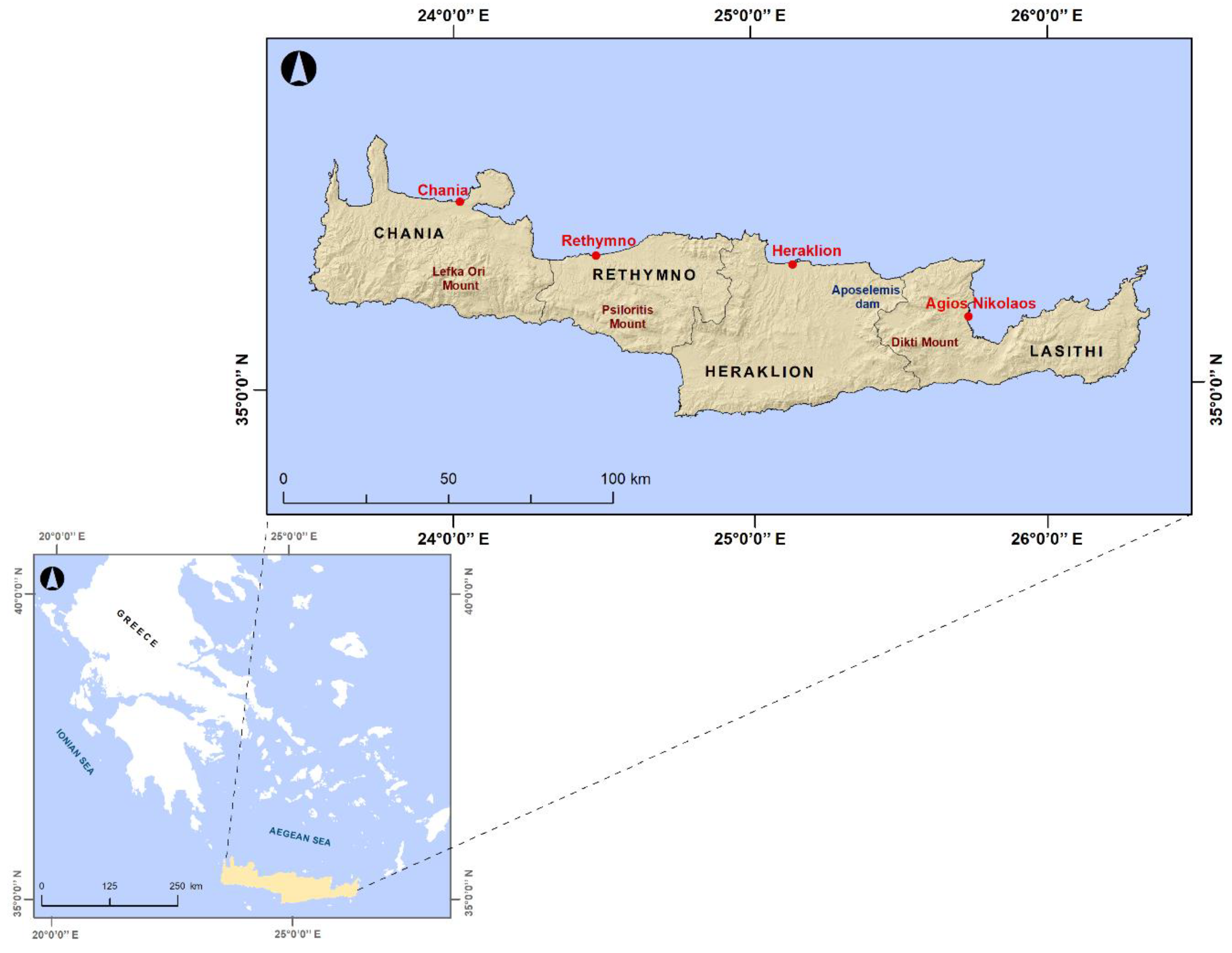
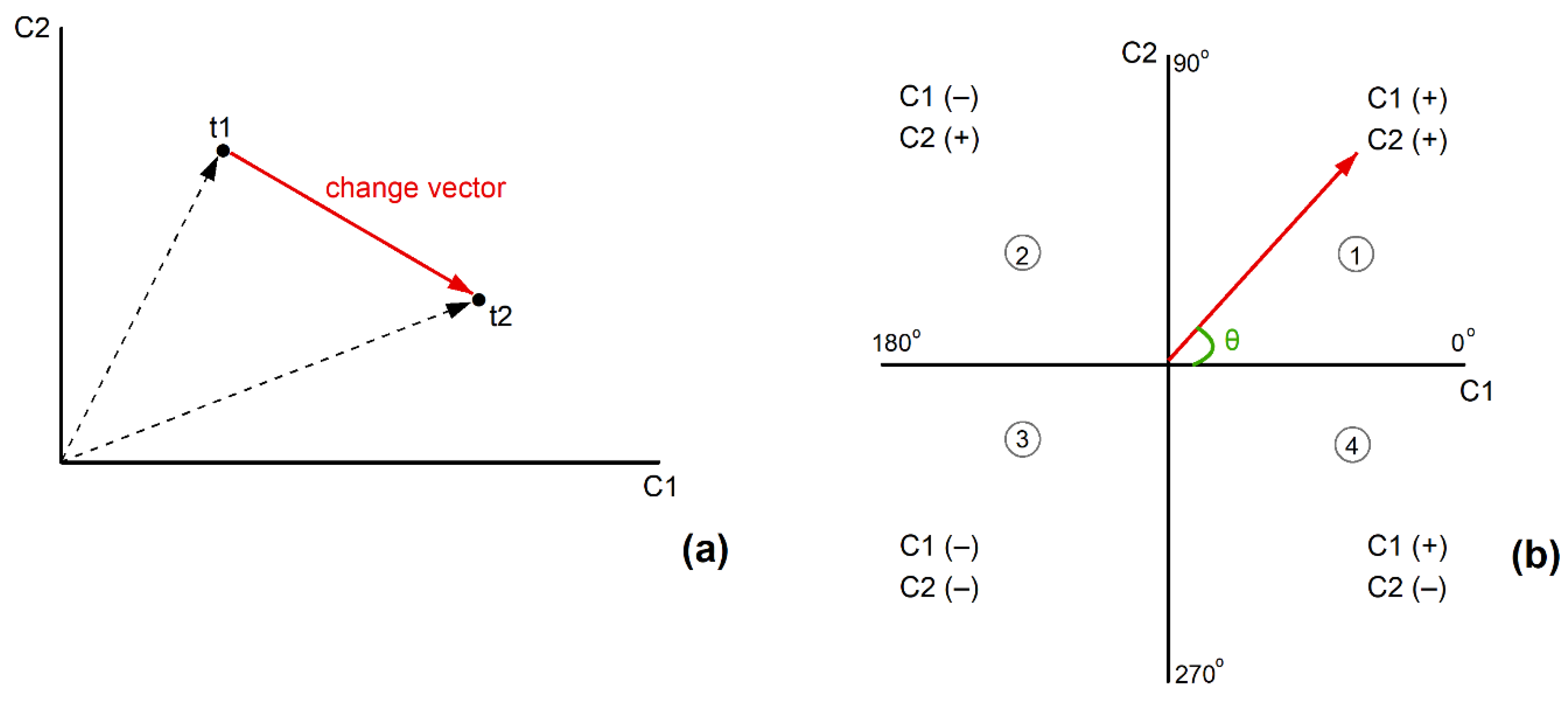
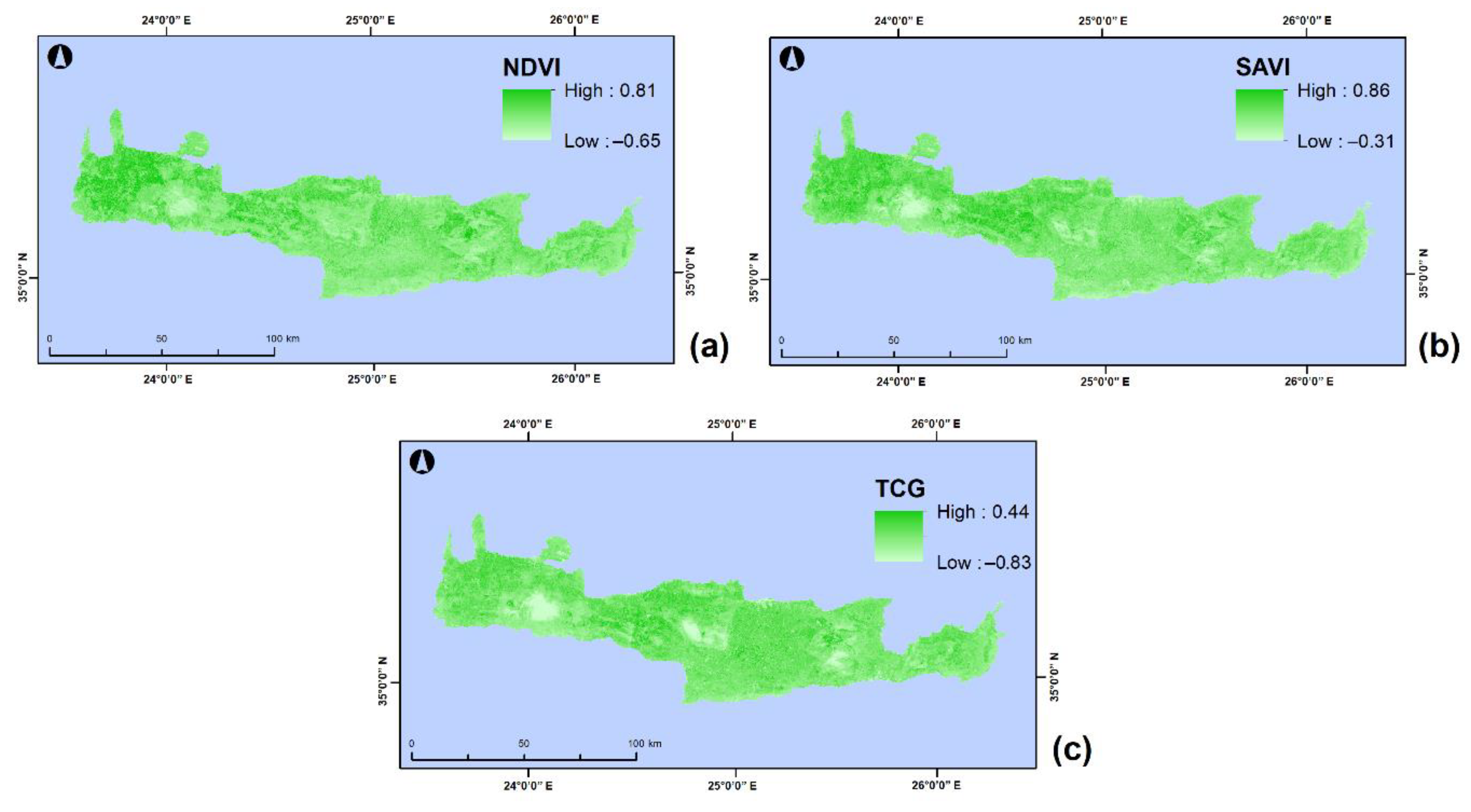
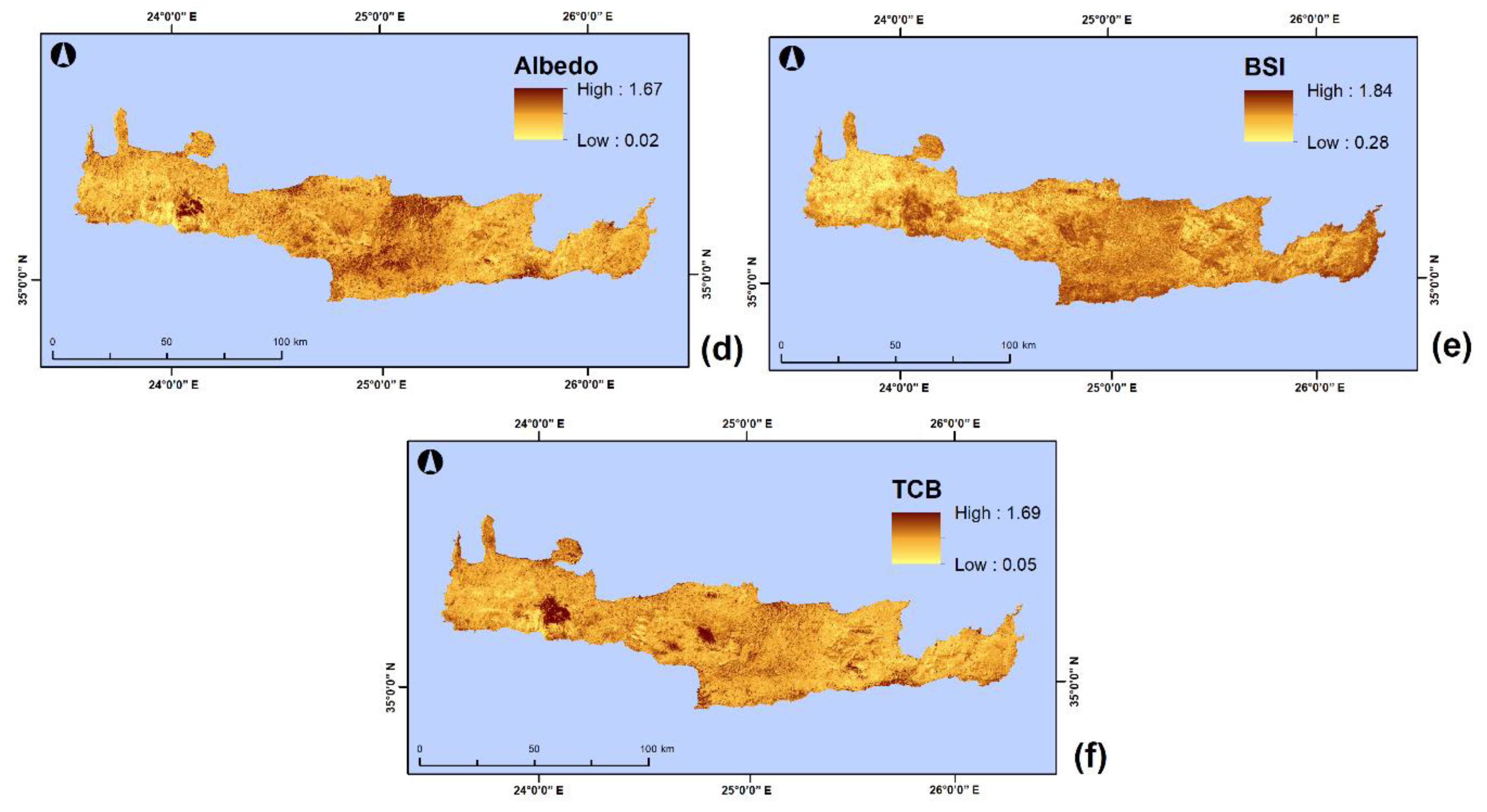

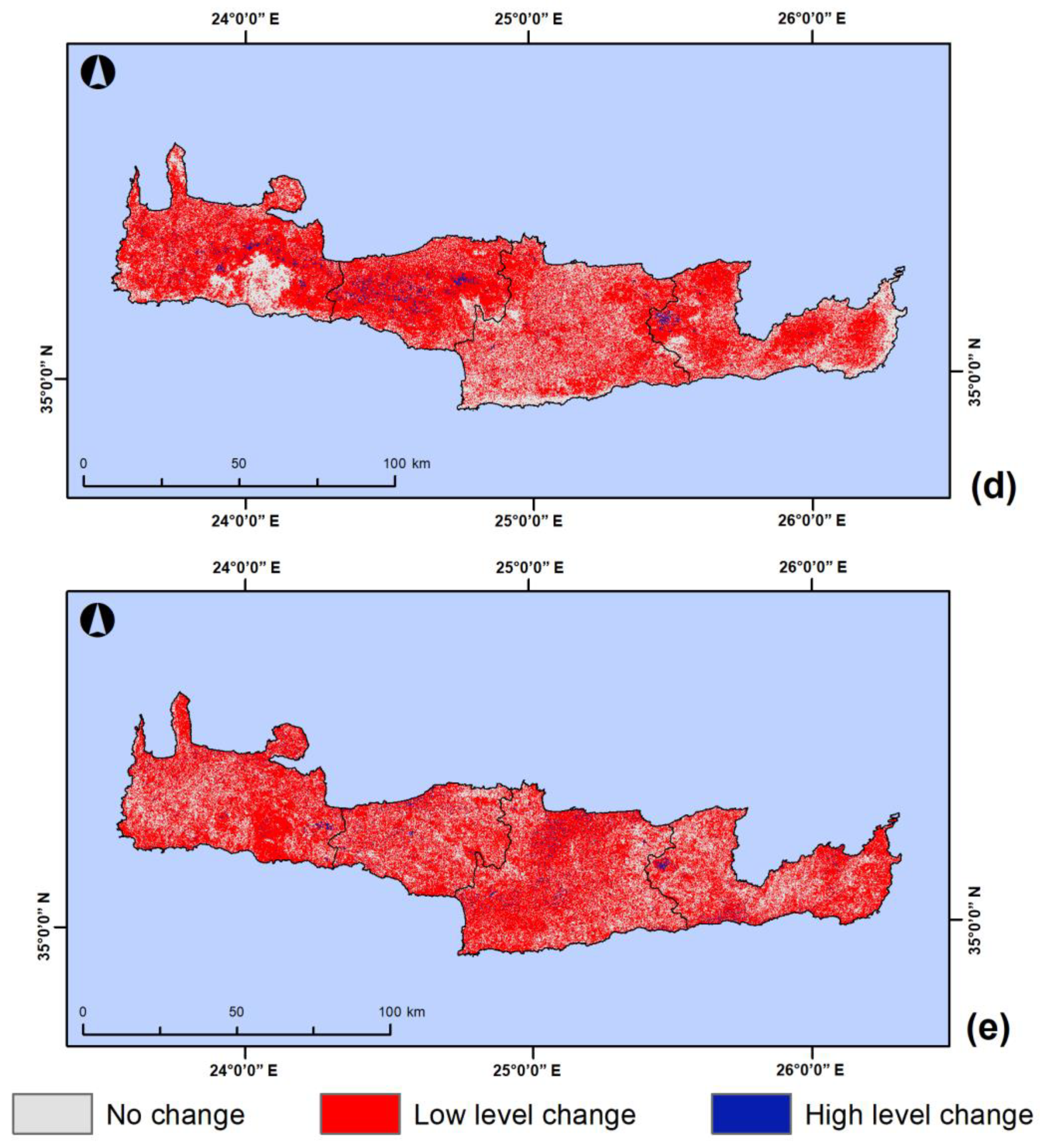


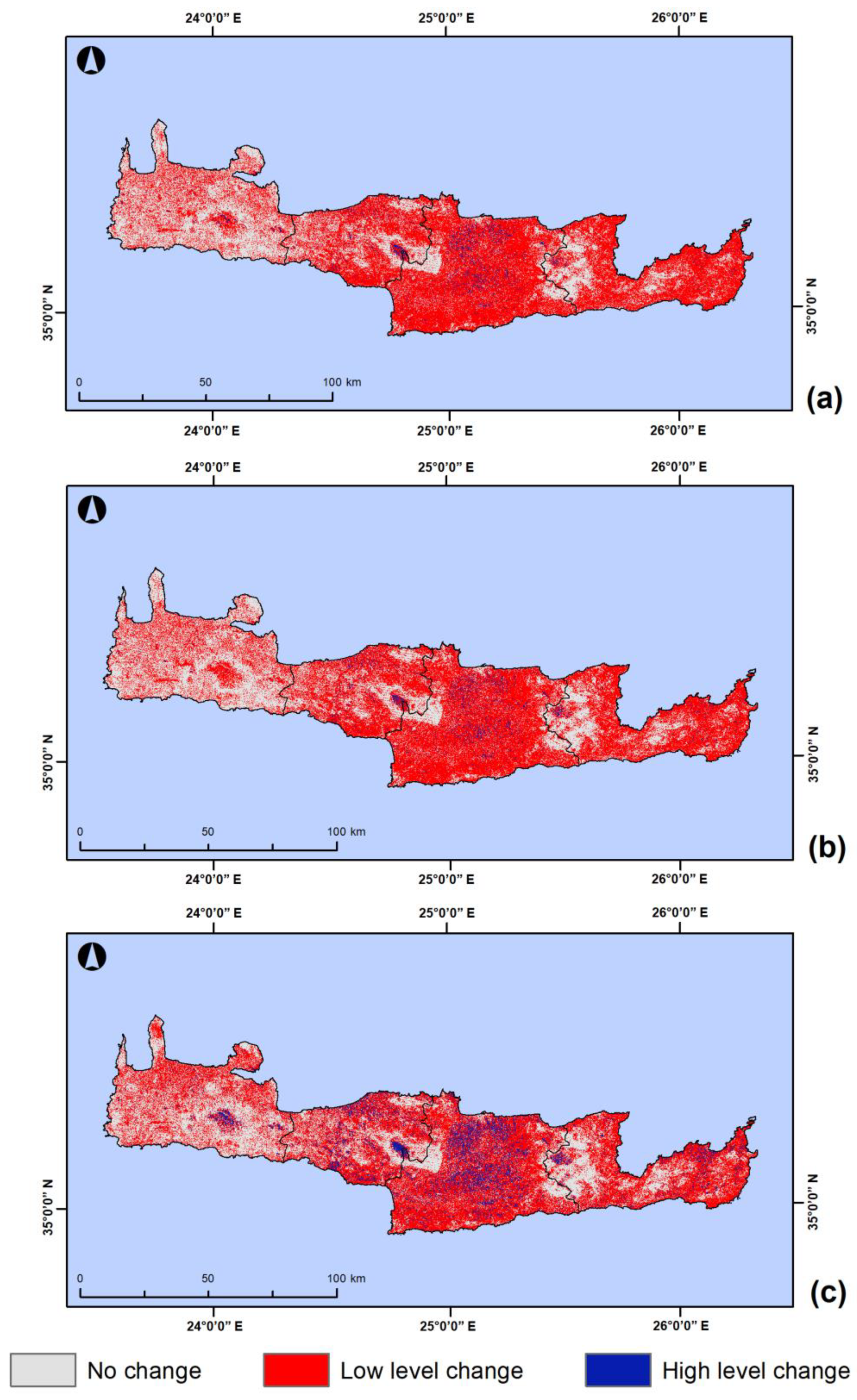
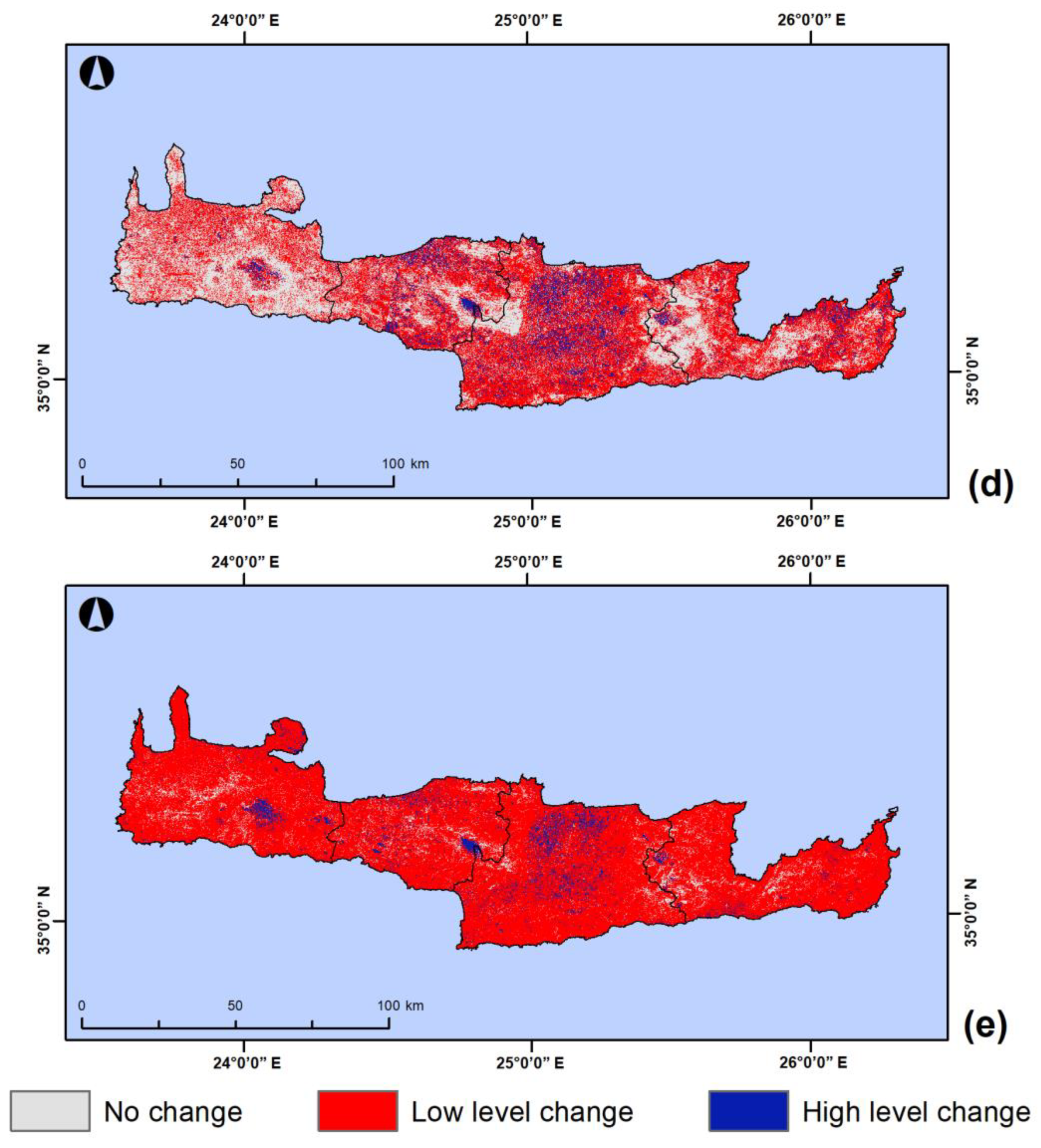

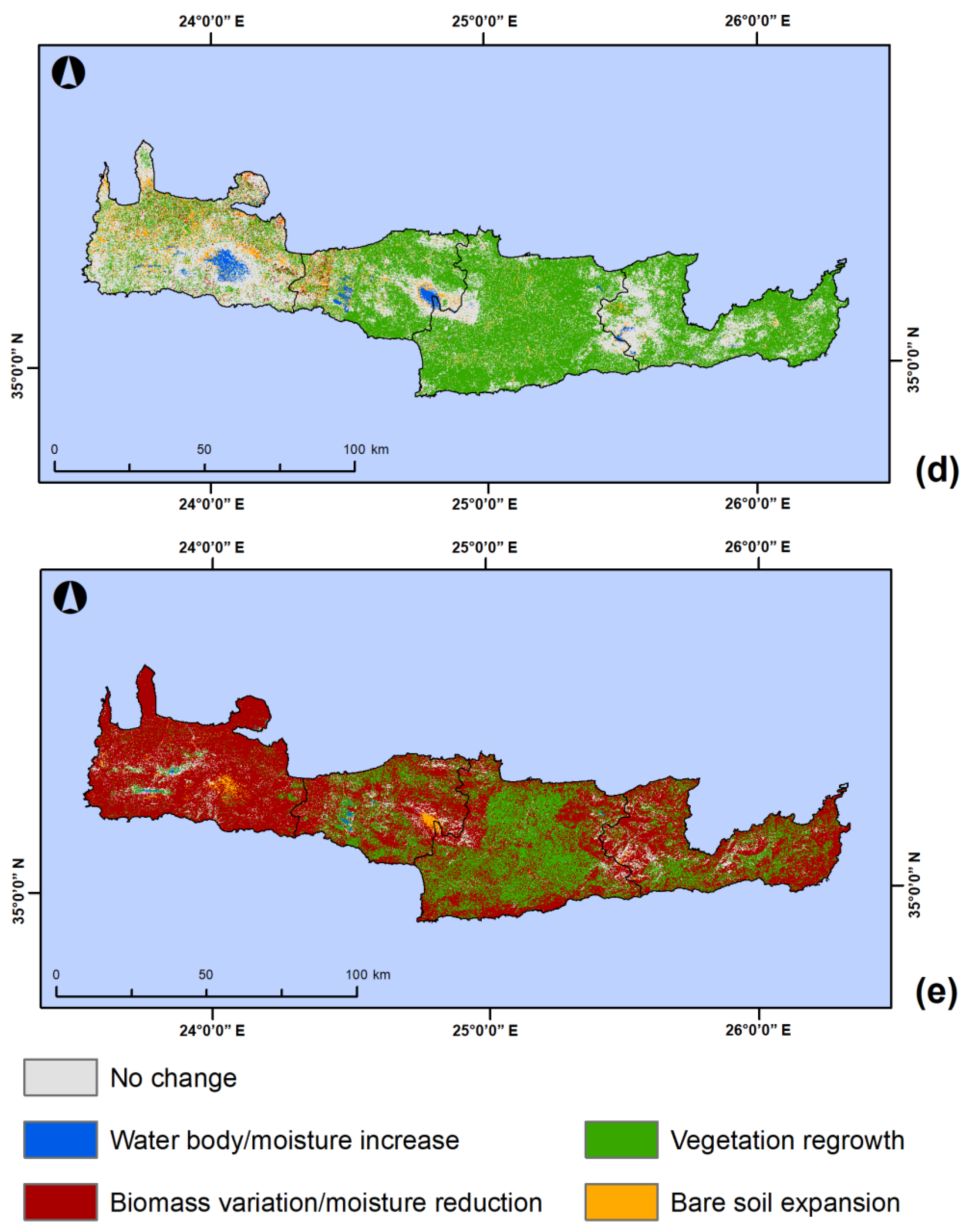

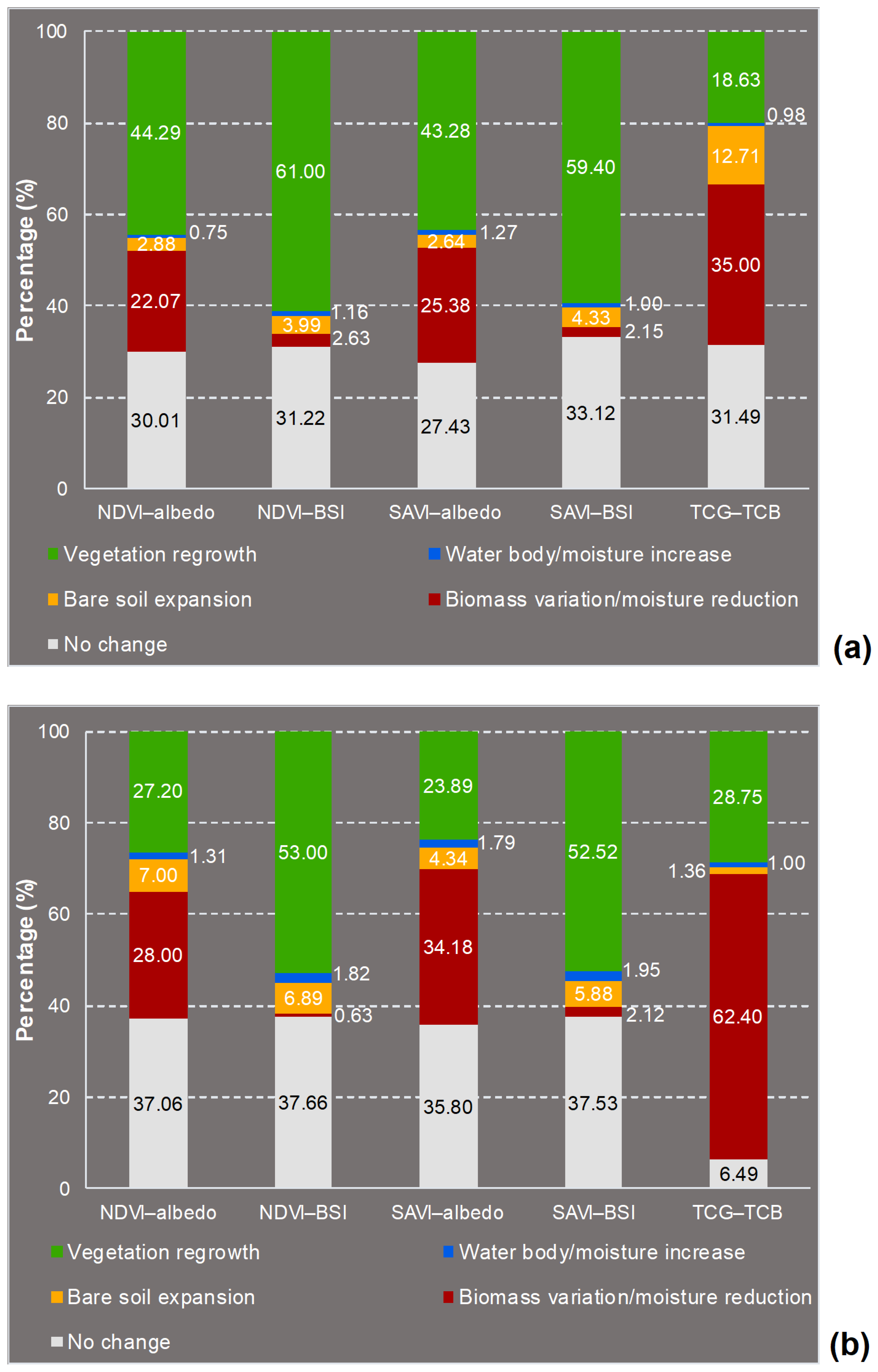
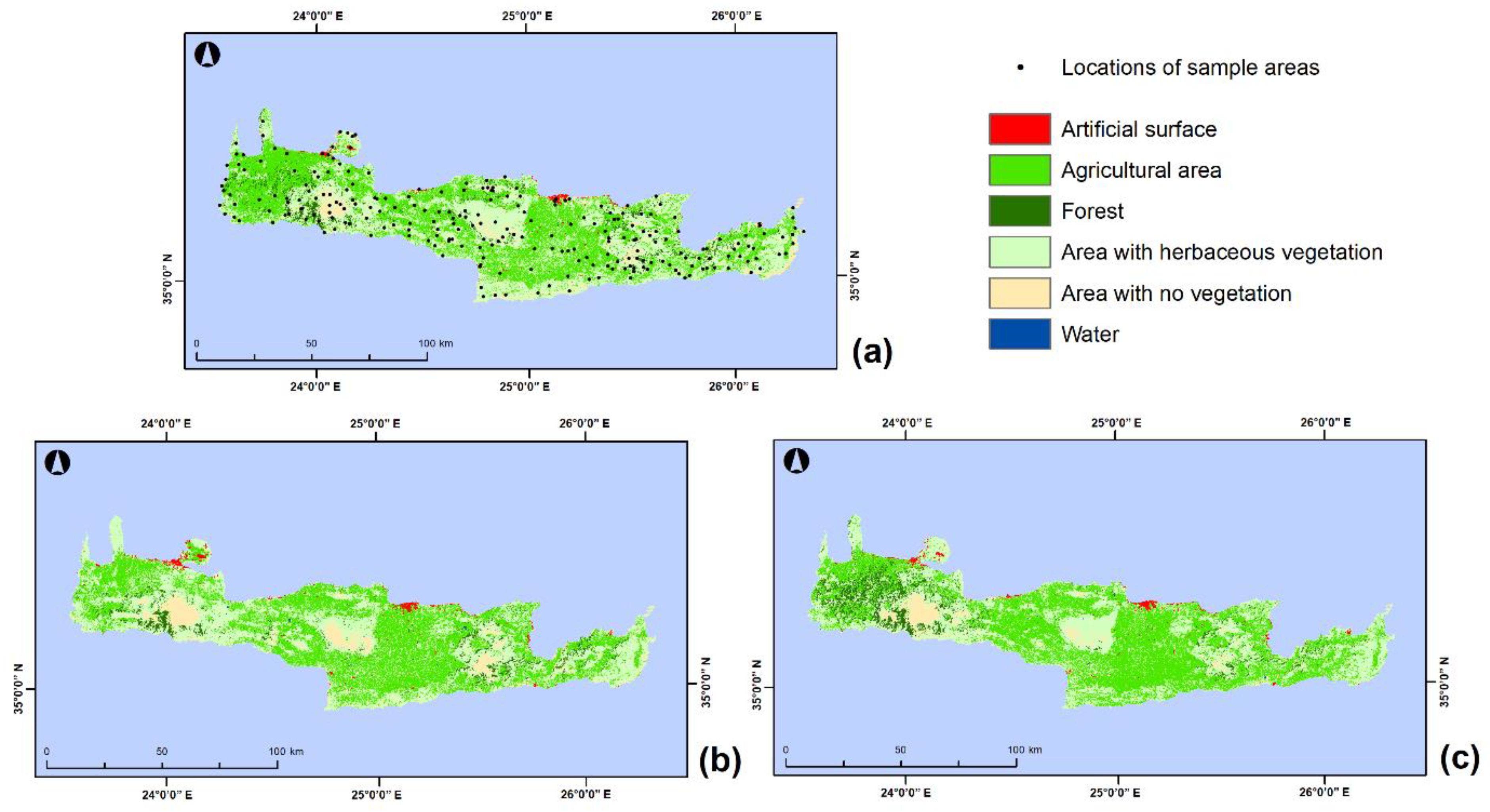

| Satellite Sensor | Index | Bands | |||||
|---|---|---|---|---|---|---|---|
| BLUE | GREEN | RED | NEAR-INFRARED (NIR) | SHORT-WAVE INFRARED 1 (SWIR1) | SHORT-WAVE INFRARED 2 (SWIR2) | ||
| Landsat 5 TM | Greenness | –0.2848 | –0.2435 | –0.5436 | 0.7243 | 0.0840 | –0.1800 |
| Brightness | 0.3037 | 0.2793 | 0.4743 | 0.5585 | 0.5082 | 0.1863 | |
| Landsat 7 ETM+ | Greenness | –0.3344 | –0.3544 | –0.4556 | 0.6966 | –0.0242 | –0.263 |
| Brightness | 0.3561 | 0.3972 | 0.3904 | 0.6966 | 0.2286 | 0.1596 | |
| Landsat 8 OLI | Greenness | –0.2941 | –0.243 | –0.5424 | 0.7276 | 0.0713 | –0.1608 |
| Brightness | 0.3029 | 0.2786 | 0.4733 | 0.5599 | 0.5080 | 0.1872 | |
| Time Period | Index Combination | Change/No Change (Magnitude) | Type of Change (Direction) | ||
|---|---|---|---|---|---|
| Kappa Index | Overall Accuracy | Kappa Index | Overall Accuracy | ||
| 1999–2009 | NDVI–albedo | 0.672 1 | 0.954 | 0.637 | 0.887 |
| NDVI–BSI | 0.669 | 0.949 | 0.590 | 0.862 | |
| SAVI–albedo | 0.664 | 0.943 | 0.626 | 0.884 | |
| SAVI–BSI | 0.668 | 0.949 | 0.591 | 0.863 | |
| TCG–TCB | 0.663 | 0.943 | 0.590 | 0.861 | |
| 2009–2019 | NDVI–albedo | 0.686 | 0.960 | 0.637 | 0.896 |
| NDVI–BSI | 0.676 | 0.954 | 0.612 | 0.883 | |
| SAVI–albedo | 0.673 | 0.946 | 0.631 | 0.889 | |
| SAVI–BSI | 0.675 | 0.950 | 0.616 | 0.884 | |
| TCG–TCB | 0.641 | 0.938 | 0.605 | 0.880 | |
© 2020 by the authors. Licensee MDPI, Basel, Switzerland. This article is an open access article distributed under the terms and conditions of the Creative Commons Attribution (CC BY) license (http://creativecommons.org/licenses/by/4.0/).
Share and Cite
Polykretis, C.; Grillakis, M.G.; Alexakis, D.D. Exploring the Impact of Various Spectral Indices on Land Cover Change Detection Using Change Vector Analysis: A Case Study of Crete Island, Greece. Remote Sens. 2020, 12, 319. https://doi.org/10.3390/rs12020319
Polykretis C, Grillakis MG, Alexakis DD. Exploring the Impact of Various Spectral Indices on Land Cover Change Detection Using Change Vector Analysis: A Case Study of Crete Island, Greece. Remote Sensing. 2020; 12(2):319. https://doi.org/10.3390/rs12020319
Chicago/Turabian StylePolykretis, Christos, Manolis G. Grillakis, and Dimitrios D. Alexakis. 2020. "Exploring the Impact of Various Spectral Indices on Land Cover Change Detection Using Change Vector Analysis: A Case Study of Crete Island, Greece" Remote Sensing 12, no. 2: 319. https://doi.org/10.3390/rs12020319
APA StylePolykretis, C., Grillakis, M. G., & Alexakis, D. D. (2020). Exploring the Impact of Various Spectral Indices on Land Cover Change Detection Using Change Vector Analysis: A Case Study of Crete Island, Greece. Remote Sensing, 12(2), 319. https://doi.org/10.3390/rs12020319








